Ascension Island
2009
"200th Anniversary of the birth of Charles Darwin"
| <prev | back to index | next> |
| Issue Date | 09.11.2009 |
| ID | Michel:1090-1093; Scott: 985-988; Stanley Gibbons: 1056-1059; Yvert et Tellier: 992-99 ; Category: Dw |
| Designer | Julian Vasarhelyi, Production Co-ordination: Creative Direction (Worldwide) Ltd. |
| Stamps in set | 4 |
| Value |
35p - Charles Darwin and Woodpecker Finch 40p - Charles Darwin and Marine Iguana 50p - Charles Darwin and Galapagos Tortoise £2 - Charles Darwin and Galapagos Penguin |
| Emission/Type | commemorative |
| Issue place | Georgetown, Ascension Island |
| Size (width x height) | 28.45mm x 42.58mm |
| Layout | Four Mini-Sheets of 10 stamps each |
| Products | FDC x1, MS x4 |
| Paper | |
| Perforation | 14 |
| Print Technique | Stochastic lithography |
| Printed by | Printer: BDT International Production; Co-ordination: Creative Direction (Worldwide) Ltd. |
| Quantity | |
| Issuing Authority | Philatelic Bureau, Ascension Island Post Office |
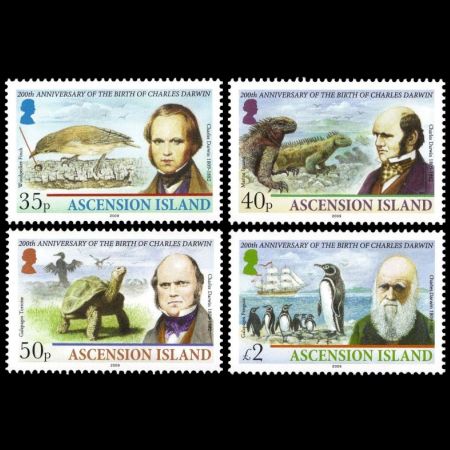
2009 was both the 200th Anniversary or bicentenary of the birth of Charles Robert Darwin, and the 150th anniversary of the publication of his most famous work "On the Origin of Species by Means of Natural Selection". Many postal authorities around the world, including Ascension Island issued stamps to celebrate one or both of these a anniversaries.
Below are quotes from an official press release, published by Ascension Island Post Office & Philatelic Bureau in 2009 (unavailable on their website today).
Charles Darwin was born in Shrewsbury, Shropshire in Great Britain in February 1809, to a wealthy and well-connected family. He had initially planned to study medicine at Edinburgh University but later switched to Divinity at Cambridge. Best known for his theory of evolution, Darwin was fundamental in discovering how all species of life developed from a central ancestor, changing the way we think about how we came to be as humans. He was a naturalist who searched the globe for new species of flora and fauna and then worked on his theory for 20 years before publishing his most famous work, "On the Origin of Species by Means of Natural Selection".
In 1831, Charles Darwin joined a five-year scientific expedition on HMS Beagle, which visited Ascension Island in 1836.
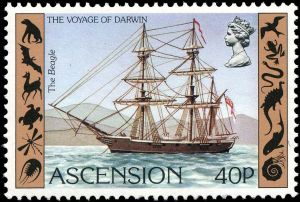 |
| HMS Beagle on stamp of Ascension Island 1982, MiNr.: 317, Scott: 308. |
On Ascension it was the geology that interested Darwin, recording his experiences and findings in the third chapter of his "Volcanic Islands". Of particular interest was the Devil’s Riding School, shown on the First Day Cover.
Situated on the South Westerly part of Ascension, evidence has revealed that there once was a lake but it dried out and subsided in the centre due to volcanic eruptions. Darwin visited the area and collected samples from a layer of pinkish pumiceous ash, which was full of the siliceous remains of diatoms and 25 other types of plant material; evidence to show the lake had existed.
It was later discovered by other geologists that the volcanic ash beds were composed of finely pulverized rock in sub-horizontal bands of white, pink and buff colour, representing successive discrete phases of eruptions. One layer contains the curious concretions called "Devil’s Eyeballs" by islanders, and another containing the abundant remains of organic life. Darwin was fascinated by the area and that’s why it has become a place of Outstanding Natural Beauty and Geological Interest.
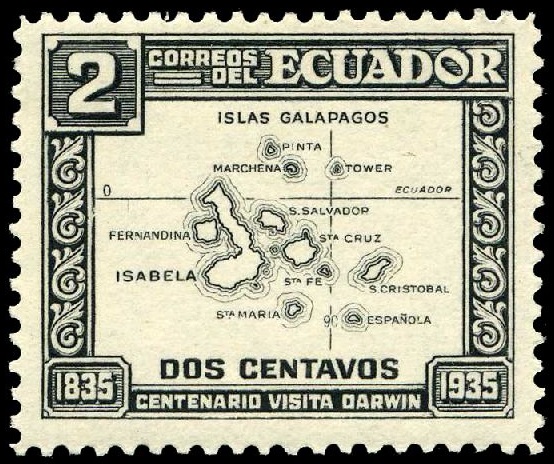 |
| Map the Galapagos Archipelago of on stamp of Ecuador, MiNr.: 317, Scott: 340. |
However Darwin’s great breakthrough came when he set foot on the Galapagos Archipelago in 1835. This 5 week visit would eventually change the way we see the world, although he didn’t know it at the time. Comprising of more than 200 islands, islets and outcrops in the Pacific Ocean off the coast of South America, nearly 9,000 species live on and around the Galapagos Islands.
An unusually high proportion of these are endemic and some have changed little since prehistoric times. This set from Ascension Island features some of the amazing species that Darwin encountered in the Galapagos Islands and which provided the evidence for his controversial theories of evolution and the foundation of modern biology.
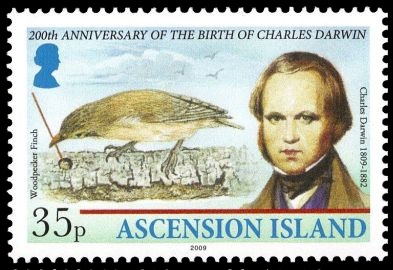 |
| Charles Darwin and Woodpecker Finch on stamp of Ascension Island 2009, MiNr.: 1090, Scott: 985. |
Darwin observed that several islands had their own form of finch which were all different but closely related. Puzzling over these birds, that differed mainly in the size and shape of their beaks, when he was back in London led Darwin towards formulating the principal of natural selection.
Subsequent research has confirmed Darwin’s belief that a single species had dispersed to different islands and then evolved into at least 13 different species as they adapted to suit different food types in a process known as adaptive radiation. As shown on the stamp, the Woodpecker Finch uniquely uses twigs and cactus spines as a tool to compensate for its short tongue if it’s unable to dislodge its prey.
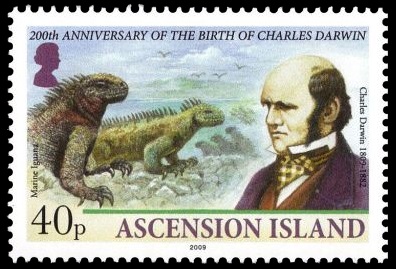 |
| Charles Darwin and Marine Iguana on stamp of Ascension Island 2009, MiNr.: 1091, Scott: 986. |
Darwin wrote that ‘the black Lava rocks on the beach are frequented by large most disgusting clumsy Lizards’. These large (3 feet or more) reptiles, which demonstrate the unique evolution and adaption of Galapagos fauna, must have fascinated Darwin who made extensive observations about them. Looking quite fearsome or ‘hideous’ as Darwin put it, they are in fact harmless. It is one of the most unusual creatures in the Galapagos and the only lizard to swim in the ocean.
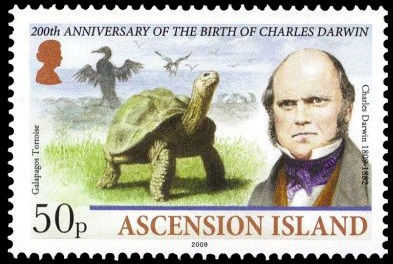 |
| Charles Darwin and Galapagos Tortoise on stamp of Ascension Island 2009, MiNr.: 1092, Scott: 987. |
The most recognised symbol of the Galapagos is perhaps the tortoise. Darwin remarked ‘These animals grow to an immense size .... several so large that it required six or eight men to lift them from the ground.’
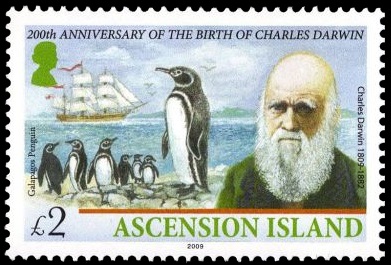 |
| Charles Darwin and Galapagos Penguins (Spheniscus mendiculus) on stamp of Ascension Island 2009, MiNr.: 1093, Scott: 988. |
£2 Galapagos Penguin (Spheniscus mendiculus)
The Galapagos Penguin is endemic to the Galapagos Islands, and the only penguin to live near the Equator. They were brought to the Galapagos by the Humboldt Current, which brings cold waters and nutrients north from Antarctica. The heat is a problem for them. Years with warmer waters from the El Nino Current can see reductions in the small population as it causes a shortfall in the small fish that they eat. To keep themselves cool in the water they will hold out their flippers and on land spread them over their feet to protect them from sunburn.
Products and associated philatelic items
| Mini Sheet | FDC (clean and circulated) | First-Day-of-Issue Postmark |
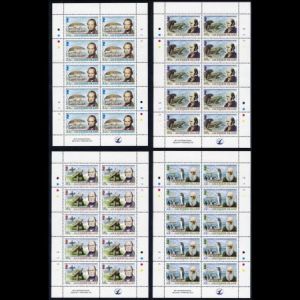 |
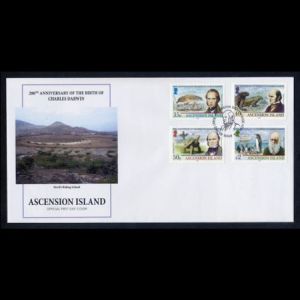 |
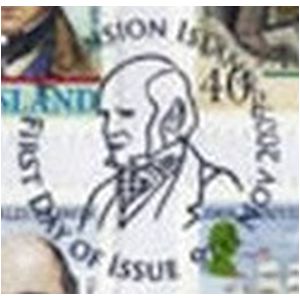 |
Some books of and about Charles Darwin
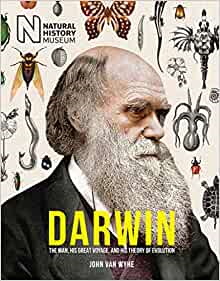
|
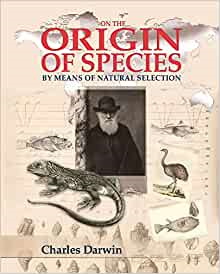
|
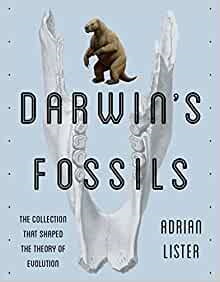
|
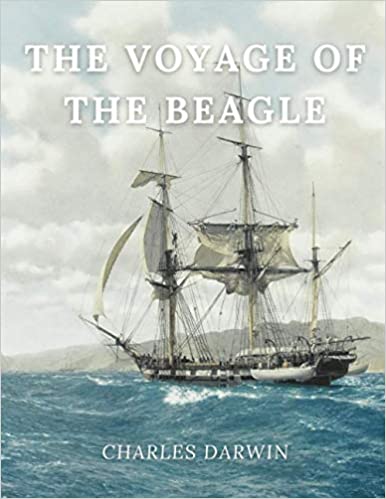
|
|
"Darwin: The Man, his great voyage, and his Theory of Evolution", by John Van Wyhe. Published in 2018. Amazon: USA, UK, DE Free PDF files from Darwin-online website: "Charles Darwin: his life and work by Charles Frederick Holder, published in 1892" |
"On the Origin of Species: By Means of Natural Selection: Slip-Cased Edition" Amazon: USA, UK, DE Free PDF files from Darwin-online website. |
"Darwin's Fossils: The Collection That Shaped the Theory of Evolution", by Adrian Lister. Published in 2018. Amazon: USA, UK, DE |
"The Voyage of the Beagle" Amazon: USA, UK, DE Free PDF files from Darwin-online website. |
References

|
Acknowledgements
Many thanks to Dr. Peter Voice from Department of Geological and Environmental Sciences, Western Michigan University, for reviewing the draft page and his very valuable comments.| <prev | back to index | next> |